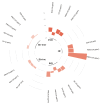Clearing the Air to Address Pollution's Cardiovascular Health Crisis
- PMID: 39479259
- PMCID: PMC11523843
- DOI: 10.5334/gh.1364
Clearing the Air to Address Pollution's Cardiovascular Health Crisis
Abstract
Air pollution is a critical global health issue that significantly impacts cardiovascular health. The air pollutant PM2.5 (particulate matter with a diameter of 2.5 micrometres or less) has been positioned as a leading environmental risk factor for morbidity and mortality, especially from cardiovascular diseases (CVDs). Using data from the World Health Organization (WHO), Global Health Observatory, and the United Nations Environment Programme, we explored global trends in air pollution, with a focus on PM2.5 levels, the implications for cardiovascular health, and the policy measures aimed at reducing their impact. Despite progress in reducing pollution levels in high-income countries, global trends show a limited annual reduction in PM2.5 concentration. The analysis highlights disparities between regions, with low- and middle-income countries bearing the brunt of air pollution-related CVDs. In 2019 alone, ambient air pollution was responsible for approximately 4.2 million deaths worldwide. Of these, 70% were caused by CVDs, with approximately 1.9 million deaths from ischemic heart disease and 900,000 deaths from stroke. Policy gaps remain a challenge, with many countries lacking adequate legally binding air quality standards. We recommend the adoption of WHO air quality guidelines, enhanced monitoring of air pollution levels, and increased investment in interdisciplinary research to understand the full scope of air pollution's effects on cardiovascular health. Addressing the global cardiovascular crisis linked to air pollution will require coordinated efforts from policymakers, healthcare systems, and global health organisations.
Keywords: Ambient air pollution; CVD global data; Cardiovascular health; World Heart Observatory.
Copyright: © 2024 The Author(s).
Conflict of interest statement
The authors have no competing interests to declare.
Figures












References
-
- Anderson JO, Thundiyil JG, Stolbach A. Clearing the air: A review of the effects of particulate matter air pollution on human health. J Med Toxicol. 2011; 8(2):166–75. https://link.springer.com/article/10.1007/s13181-011-0203-1. DOI: 10.1007/s13181-011-0203-1 - DOI - PMC - PubMed
-
- Institute for Health Metrics and Evaluation. Global Burden of Disease (GBD) [Internet]. Seattle, Washington: IMHE; 2021. [cited 2024 Oct 24]. Available from: https://vizhub.healthdata.org/gbd-results/.
-
- World Health Organization. The Global Health Observatory. [Internet] [cited 2024 Aug 5]. Geneva: WHO; 2019. [cited 25 Oct 2024]. Available from: https://www.who.int/data/gho.
MeSH terms
Substances
LinkOut - more resources
Full Text Sources
Medical

